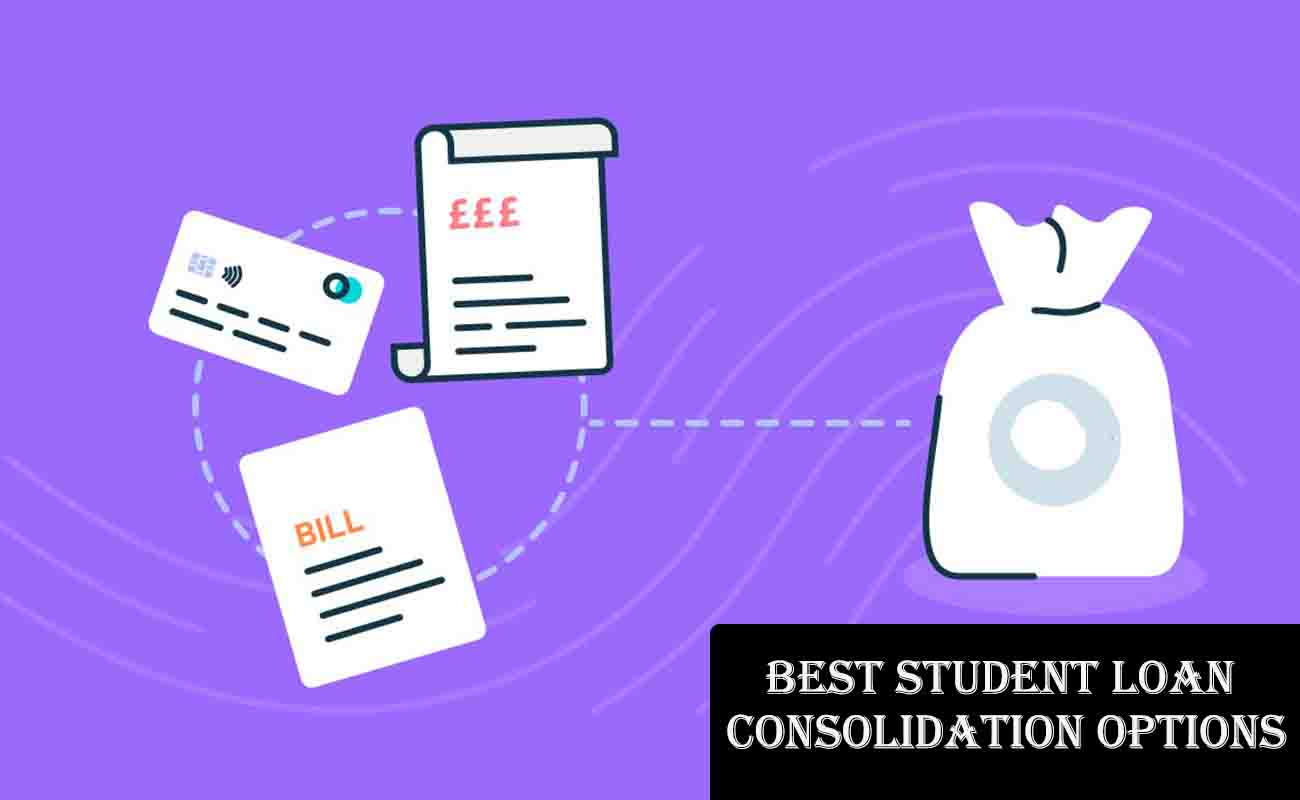When I first graduated from college, I was thrilled to start my career, but I was overwhelmed by the pile of student loan bills that arrived each month. The idea of juggling multiple payments, interest rates, and due dates felt like a full-time job. That’s where the best student loan consolidation options come in.

They simplify your debt into one manageable payment, potentially saving you money and stress. If you’re in a similar boat, wondering how to streamline your student loans, this article is for you.
I’ll walk you through what consolidation means, why it might be a good move, and the top options available, all based on my research and personal experience navigating this process.
Student loan consolidation can feel like a lifeline, but it’s not a one-size-fits-all solution. To make an informed decision, you need to understand the ins and outs. I’ve been there, staring at loan statements, trying to figure out if combining them makes sense.
In this guide, I’ll break down the best student loan consolidation options, explore federal and private routes, and share tips to help you decide what’s best for your financial future.
Best Student Loan Consolidation Options
So, what exactly are the best student loan consolidation options? In simple terms, consolidation means combining multiple student loans into one loan with a single monthly payment. This can make life easier by reducing the number of bills you track and potentially lowering your interest rate or monthly payment.
There are two main paths: federal loan consolidation and private loan consolidation. Each has its pros and cons, and I’ll explain them so you can decide what fits your needs.
Federal Student Loan Consolidation
When I looked into consolidating my federal student loans, I found the Direct Consolidation Loan to be the go-to option. This is a free program offered by the U.S. Department of Education, and it’s designed to combine all your federal loans, like Direct Subsidized, Unsubsidized, or PLUS loans, into one. Here’s how it works and why it might be right for you:
- How It Works: You apply through the Department of Education’s website (I used StudentAid.gov). Once approved, your federal loans are merged into a single loan with a fixed interest rate, which is a weighted average of your previous rates, rounded up slightly. For example, if you had loans at 4% and 6%, the new rate might land around 5%.
- Benefits: The biggest perk is simplicity—one payment, one due date. It also gives you access to federal benefits like income-driven repayment plans, which can lower your payments based on your income, and forgiveness programs like Public Service Loan Forgiveness (PSLF). I loved that I could extend my repayment term (up to 30 years) to lower monthly payments, though this means paying more interest over time.
- Drawbacks: That fixed rate might not save you money compared to private options, and extending your term increases total interest. Also, you might lose certain benefits, like interest rate discounts from your original loans. I made sure to check if any of my loans had perks I’d miss before consolidating.
- Who It’s For: If you have multiple federal loans and want access to forgiveness programs or flexible repayment plans, this is likely your best bet. It’s what I chose to keep things manageable while working a nonprofit job that qualified for PSLF.
To apply, you’ll need your loan details and some personal info. The process took me about 30 minutes online, but it can take a few months for approval and processing. Be patient—it’s worth it for the peace of mind.
Private Student Loan Consolidation
If you have private student loans or a mix of federal and private loans, private consolidation (often called refinancing) might be one of the best student loan consolidation options for you. I explored this when I noticed my private loans had higher interest rates. Here’s the lowdown:
- How It Works: Private lenders like SoFi, Earnest, or Citizens Bank take your existing loans (federal or private) and combine them into a new private loan, often with a lower interest rate if you have good credit. You apply directly with the lender, and they pay off your old loans, leaving you with one new loan.
- Benefits: The biggest draw is the potential to save money. I saw friends with strong credit scores cut their interest rates by 2-3%, which added up to thousands in savings. You can also choose shorter repayment terms to pay off your debt faster or extend terms to lower monthly payments.
- Drawbacks: Refinancing federal loans into a private loan means losing federal benefits like income-driven repayment or loan forgiveness. This was a dealbreaker for me since I was eyeing PSLF. Also, you’ll need a solid credit score (typically 650 or higher) or a co-signer to qualify for the best rates.
- Who It’s For: If you have private loans or don’t need federal benefits, and you’ve got good credit, private consolidation could save you money. It’s also great if you want to pay off your loans quickly.
I recommend shopping around with at least three lenders to compare rates. When I did this, I got pre-qualified offers without a hard credit pull, which helped me see what I’d qualify for without dinging my credit score.
Comparing Federal vs. Private Consolidation
Choosing between federal and private consolidation depends on your goals. When I was deciding, I made a pros-and-cons list to weigh my options. Here’s a quick breakdown to help you:
- Federal Consolidation:
- Pros: Keeps federal benefits, no credit check required, fixed rates.
- Cons: The Interest rate might not decrease, and longer terms mean more interest over time.
- Private Consolidation:
- Pros: Potentially lower interest rates, flexible terms, faster payoff options.
- Cons: Lose federal benefits, requires good credit, variable rates could rise.
If you’re like me and value flexibility over lower rates, federal consolidation might be your path. But if you’re confident in your income and credit, private refinancing could save you big. Always check the fine print—some private lenders charge origination fees, which I found sneaky when comparing offers.
Top Lenders for Private Consolidation
If you’re leaning toward private consolidation, here are some of the best student loan consolidation options based on my research and conversations with friends who refinanced:
- SoFi: Known for competitive rates (starting around 3.99% with autopay as of 2025) and perks like career coaching. I liked their user-friendly app and no-fee policy.
- Earnest: Offers flexible repayment terms (5-20 years) and lets you customize your monthly payment. They also have a “precision pricing” tool to find the lowest rate for your budget.
- Citizens Bank: Great for borrowers with strong credit or a co-signer. They offer fixed and variable rates, and I found their customer service super helpful when I called with questions.
- Laurel Road: Popular for professionals (like doctors or lawyers) with high debt. They offer low rates and discounts for autopay or if you bank with them.
Each lender has unique perks, so compare based on your credit score, loan amount, and repayment goals. I used comparison sites like Credible to see multiple offers at once—it saved me hours of research.
Tips for Choosing the Right Consolidation Option
When I consolidated my loans, I learned a few lessons that can help you avoid pitfalls. Here’s what I’d tell you to keep in mind:
- Know Your Goals: Are you aiming for lower payments, faster payoff, or access to forgiveness? I wanted lower payments to free up cash for rent, so federal consolidation worked for me.
- Check Your Credit: For private consolidation, a higher credit score means better rates. I boosted my score by paying off credit card debt before applying.
- Calculate Total Costs: Use loan calculators (many lenders have them online) to see how much you’ll pay over the loan’s life. I was shocked at how much interest added up on longer terms.
- Read Reviews: I checked borrower reviews on sites like Trustpilot to avoid lenders with poor customer service. You don’t want to be stuck with a company that’s hard to reach.
- Ask About Hardships: Some lenders offer forbearance or deferment if you hit financial trouble. I made sure my lender had options in case life threw curveballs.
Common Mistakes to Avoid
I’ve seen friends make missteps when consolidating, and I nearly made a few myself. Here are pitfalls to dodge:
- Rushing the Decision: Don’t jump at the first offer. I almost went with a lender because their ad was everywhere, but comparing saved me $2,000 in interest.
- Ignoring Federal Benefits: If you’re eligible for PSLF or income-driven repayment, think twice before going private. I know someone who refinanced and regretted losing forgiveness options.
- Missing Payments During Transition: Consolidation can take weeks or months. Keep paying your current loans until the new one kicks in—I set calendar reminders to stay on track.
- Not Shopping Around: Rates and terms vary widely. I got quotes from three lenders and saved 1% on my rate just by comparing.
FAQs About Student Loan Consolidation
Here are some questions I had (and you might too) when I started exploring consolidation:
Q: Will consolidation hurt my credit score?
A: Applying for private consolidation might cause a small, temporary dip due to a hard credit inquiry. Federal consolidation doesn’t require a credit check, so it’s safer for your score. I checked my credit report before applying to know where I stood.
Q: Can I consolidate just some of my loans?
A: Yes! You can choose which federal loans to include in a Direct Consolidation Loan or which loans to refinance with a private lender. I left out a low-interest loan to keep its benefits.
Q: How long does consolidation take?
A: Federal consolidation took me about two months from application to first payment. Private refinancing can be faster—sometimes a few weeks—depending on the lender.
Q: Can I switch back to federal loans after refinancing?
A: No, once you refinance federal loans into a private loan, you can’t go back. That’s why I stuck with federal consolidation to keep my options open.
Q: Are there fees for consolidation?
A: Federal consolidation is free. Private lenders might charge origination fees, but many (like SoFi) don’t. I always checked the fine print for hidden costs.
Conclusion
Navigating the best student loan consolidation options can feel like a maze, but it’s a journey worth taking if it means less stress and more control over your finances. I remember the relief I felt when my loans were consolidated into one payment—it was like clearing mental clutter.
Whether you choose federal consolidation for its flexibility or private refinancing for potential savings, take the time to weigh your options, crunch the numbers, and pick what aligns with your goals.
